Originally posted by RavFX
View Post
Also to my knowledge, I don't think MCO works on non-K series CPUs, but I might be wrong about that.
Edit : MCO is also not by Intel spec. I wonder if they did not get paid by Intel to do that (for when higher 8700 are benched again Ryzen CPU... to assure more win to Intel... Hard to know who the fault is. Some reviewer did contact ASUS to know about and Asus did think that it was disabled by default... So Even them, don't know what is happening on the BIOS side..)






Comment